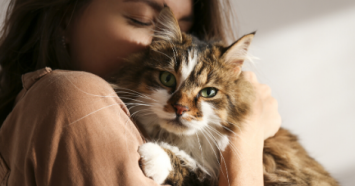
Even if you bear treats and wet food, it’s likely that your cat has been standoffish or avoided you at some point. If your cat is consistently aloof or mistrustful, you might wonder, “Do cats love their owners?” Of course, they do! But cats feel and express their feelings acutely, and their asocial moods can be a real heartbreaker for the cat lover who is trying their best to get a cat to love them. Don’t give up. You just need to find how to bond with your cat to build a closer, mutually loving relationship.
Signs Your Cat Loves You
Cats don’t always show affection and appreciation the way people are accustomed to, especially if you’re used to dogs. Instead of a wagging tail or bringing you a toy, your cat is more likely to do these things to show you they appreciate you:
Headbutting: When a cat rubs their head on you, they’re rubbing their scent gland on you, literally claiming you as their own.
Showing you their belly: When an animal rolls over to expose their belly, they’re showing you that they trust you. In a primal way, they know you aren’t a threat and consider you a safe companion.
Relaxed eyes: Slow blinking, squinting, and peaceful expressions tell a lot about how your cat feels. If you see sleepy expressions when they’re near you, they’re relaxed and enjoying your company.
Swishy or curled tail: Cat tails can tell you a bit about how they’re feeling. If your cat’s tail is twitchy or fluffed up, they may be anxious. But a tail that is swishing softly or curled around your leg means they’re feeling friendly and affectionate.
How to Bond with Your Cat
If you don’t see positive signs regularly, it can be frustrating to figure out how to get your cat to like you, but there are simple ways you can build their trust and the bond between you. The tricks to winning a cat’s affection come down to food, touch, and playtime. Here’s what you should do:
Feed with Love
If a cat is avoiding a particular person, they should endear themselves to the cat by assuming sole feeding duty. Wet food, crunchies, treats, catnip, you name it – all of it comes only from the person needing the boost in feline ranking status.
Treat time is also the best time to figure out how to get your cat to come to you. Start by standing a few feet away and call them to you by name or with the clicky/chirpy sounds that mean you’re looking for them. When they come to you, give them the treat. This can become your regular ritual and a great way to build a bond with your cat.
Playtime is Bonding Time
Take time to figure out what sort of games your cat enjoys. Do they love cloth mouse on a string? Swatting a piece of foil? Rope scratcher? Laser pointer? Once you find out your cat’s playing style and how to play with them, take frequent short breaks to play.
My dad was a huge hit with our cats just throwing the ring from the top of the milk jug lid to them. It was their thing. Once you figure out what your special activity is, your cat will come looking to you for that fun.
Happy Touch
Physical affection is a tricky thing with many cats. Some love it and fall asleep cradled in your arms while purring. Others are okay with being touched on their own terms. The first step you’ll want to take is to teach your cat to enjoy being held. This takes time and patience but will ultimately go a long way in earning their trust.
It’s also good to know where like to be petted. They’re not responsive to the same rough scratching behind the ears you might be used to giving a dog. Start with soft touching around the cheeks, forehead, between the ears, and shoulders. Generally, cats prefer stroking motion that runs from the head toward the tail, but not lifting or ruffling the fur. Try to avoid touching their back, tail, and tummy, unless your cat signals to you that they’re looking for scratches in these spots.
It’s okay to stop petting your cat when you’re done, even if they don’t seem ready. And if they suddenly swat or nip at you after a few minutes of petting, it doesn’t mean you did anything wrong. It’s common for cats to feel overstimulated and they can get a bit snappy when they need a break.
As you earn your cat’s trust, they’re likely to seek affection and physical interaction. Brushing, belly rubs, and snuggles all come with time. And if they don’t, you’ll find other ways to connect with your cat.
Be patient and take your time. Even if it’s a long process, earning your cat’s trust, and eventual loyalty, is one of the most rewarding experiences you can have as a cat guardian.